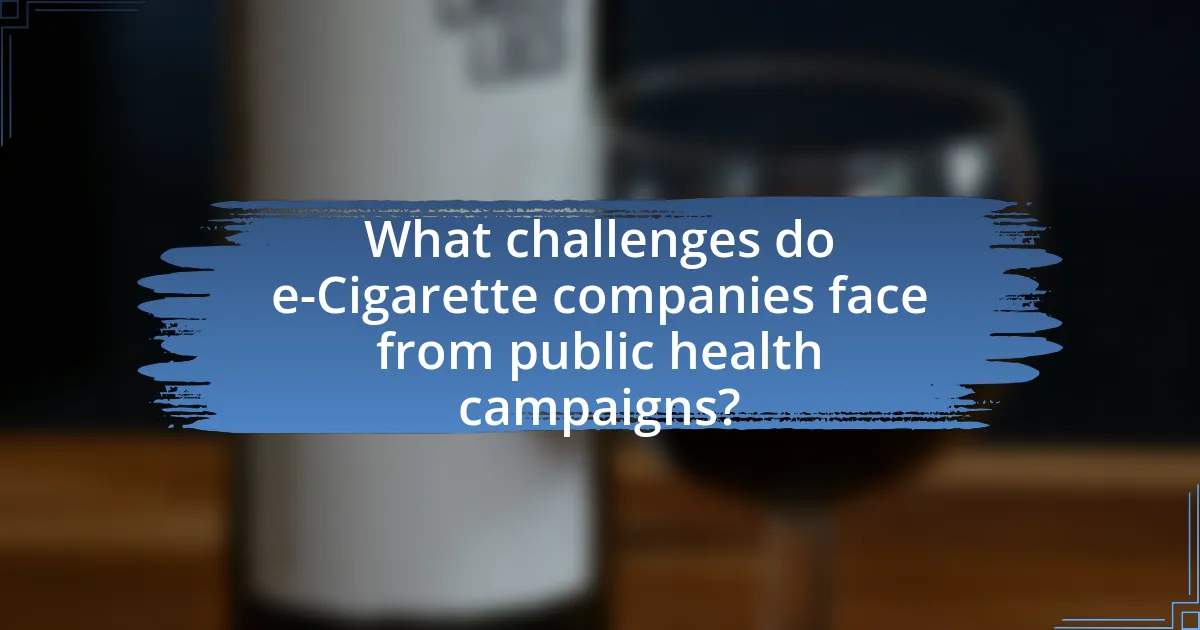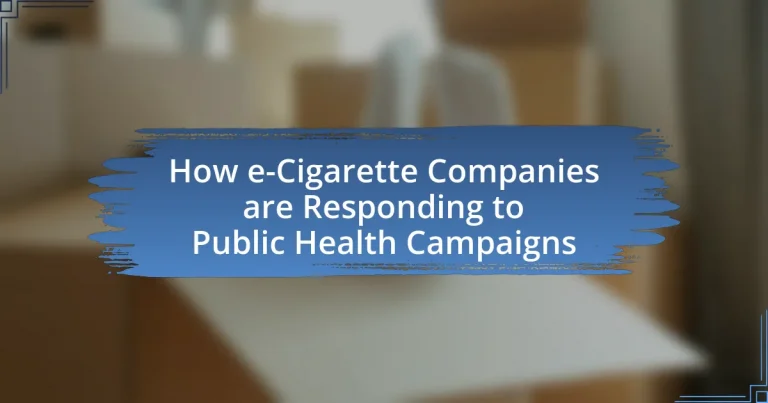The article examines how e-cigarette companies are responding to public health campaigns aimed at reducing vaping, particularly among youth. It outlines the marketing strategies employed by these companies, such as emphasizing harm reduction and collaborating with health organizations to provide educational resources. The article also discusses key public health campaigns targeting e-cigarette use, the evolution of these campaigns over time, and the specific health risks highlighted. Furthermore, it explores the challenges faced by e-cigarette companies due to regulatory pressures and negative public perceptions, as well as the strategies they adopt to navigate these challenges and improve their image.

How are e-Cigarette Companies Addressing Public Health Campaigns?
e-Cigarette companies are addressing public health campaigns by implementing marketing strategies that emphasize harm reduction and promoting their products as safer alternatives to traditional smoking. For instance, companies like Juul have launched campaigns highlighting the reduced health risks associated with vaping compared to combustible cigarettes, supported by studies indicating that e-cigarettes can be less harmful. Additionally, some e-cigarette manufacturers are collaborating with public health organizations to provide educational resources about vaping, aiming to position themselves as responsible players in the tobacco industry. This approach is evident in initiatives where companies participate in community outreach programs to inform consumers about the potential benefits and risks of their products, thereby attempting to align with public health objectives.
What are the key public health campaigns targeting e-Cigarette use?
Key public health campaigns targeting e-cigarette use include the “Truth Initiative,” which aims to educate youth about the risks of vaping through impactful advertising and social media outreach. Another significant campaign is the “CDC’s Tips From Former Smokers,” which highlights personal stories of individuals affected by tobacco use, including e-cigarettes, to raise awareness about health risks. Additionally, the “Campaign for Tobacco-Free Kids” focuses on policy advocacy and public education to reduce youth access to e-cigarettes. These campaigns are supported by research indicating that youth vaping has increased significantly, with the 2021 National Youth Tobacco Survey reporting that 19.6% of high school students used e-cigarettes, underscoring the need for effective public health interventions.
How have these campaigns evolved over time?
Public health campaigns targeting e-cigarette use have evolved significantly over time, adapting to changing perceptions and emerging research on vaping. Initially, campaigns focused on raising awareness about the potential health risks associated with e-cigarettes, often drawing parallels to traditional tobacco products. As evidence of the specific health impacts of vaping emerged, campaigns began to emphasize the dangers of nicotine addiction and the appeal of e-cigarettes to youth. For instance, the CDC’s “Tips From Former Smokers” campaign has shifted to include messaging specifically addressing e-cigarette use among adolescents, highlighting the increase in vaping among high school students from 1.5% in 2011 to 20.8% in 2018. Furthermore, recent campaigns have incorporated digital platforms and social media to reach younger audiences more effectively, reflecting the changing landscape of communication and marketing. This evolution demonstrates a responsive approach to public health messaging, informed by ongoing research and societal trends.
What specific health risks are highlighted in these campaigns?
The specific health risks highlighted in these campaigns include respiratory issues, cardiovascular diseases, and potential nicotine addiction. Research indicates that e-cigarette use can lead to lung damage, with studies showing that inhaling e-cigarette vapor can cause inflammation and oxidative stress in lung tissues. Additionally, the American Heart Association has reported that e-cigarette use is associated with an increased risk of heart disease due to the harmful effects of nicotine and other chemicals present in the vapor. These campaigns aim to raise awareness about these risks to inform the public and reduce e-cigarette usage.
How do e-Cigarette companies perceive public health campaigns?
e-Cigarette companies generally perceive public health campaigns as a threat to their business model and market share. These companies often argue that such campaigns misrepresent the safety and benefits of their products compared to traditional tobacco smoking. For instance, a study published in the journal Tobacco Control highlighted that e-Cigarette manufacturers frequently criticize public health messaging for promoting misinformation, which they claim undermines consumer choice and the potential harm reduction benefits of vaping. This perception leads e-Cigarette companies to engage in counter-campaigns that emphasize their products as safer alternatives, aiming to reshape public discourse around vaping and its health implications.
What are the common responses from e-Cigarette companies?
e-Cigarette companies commonly respond to public health campaigns by emphasizing the harm reduction potential of their products compared to traditional cigarettes. They often argue that e-cigarettes can help smokers quit or reduce their tobacco consumption, citing studies that support this claim. For instance, a study published in the journal “Tobacco Control” found that e-cigarettes are more effective than nicotine replacement therapies for smoking cessation. Additionally, these companies frequently challenge the validity of health claims made against vaping, asserting that the risks are overstated and that their products are subject to regulatory scrutiny. They also engage in marketing strategies that highlight their commitment to responsible use and consumer education, aiming to counteract negative perceptions and promote their products as safer alternatives.
How do these perceptions influence company strategies?
Perceptions of public health campaigns significantly influence e-cigarette companies’ strategies by prompting them to adapt their marketing and product development approaches. For instance, negative perceptions regarding the health risks associated with e-cigarettes lead companies to emphasize harm reduction and promote their products as safer alternatives to traditional smoking. This strategic shift is evidenced by companies investing in research to substantiate claims of reduced harm, as seen in studies published by the National Institute on Drug Abuse, which highlight the potential for e-cigarettes to serve as cessation tools. Additionally, e-cigarette companies often adjust their advertising to align with public sentiment, focusing on responsible use and compliance with regulations to mitigate backlash from health advocates and regulators.
What strategies are e-Cigarette companies employing in response to public health campaigns?
e-Cigarette companies are employing strategies such as targeted marketing, product diversification, and lobbying efforts in response to public health campaigns. Targeted marketing focuses on appealing to specific demographics, particularly younger audiences, through social media and influencer partnerships, which can counteract negative perceptions created by health campaigns. Product diversification includes introducing new flavors and nicotine strengths to attract consumers and maintain market interest despite regulatory pressures. Additionally, lobbying efforts aim to influence legislation and public policy to create a more favorable regulatory environment, as seen in various industry-funded campaigns that challenge the validity of health claims against e-cigarettes. These strategies reflect the companies’ attempts to mitigate the impact of public health initiatives that aim to reduce e-cigarette usage.
How are companies adjusting their marketing tactics?
Companies are adjusting their marketing tactics by shifting focus from traditional advertising to digital platforms and social media engagement. This change is driven by increasing regulations on advertising e-cigarettes, which limit exposure in conventional media. For instance, e-cigarette companies are utilizing influencer partnerships and targeted online campaigns to reach younger audiences while navigating restrictions. Research indicates that 70% of e-cigarette marketing now occurs online, reflecting a strategic pivot to adapt to public health campaigns and regulatory pressures.
What role does product innovation play in their response?
Product innovation plays a crucial role in how e-cigarette companies respond to public health campaigns by enabling them to develop new products that align with consumer preferences and regulatory demands. For instance, companies have introduced nicotine salt formulations and pod systems that appeal to users seeking a less harmful alternative to traditional smoking. This innovation not only addresses health concerns but also helps companies differentiate themselves in a competitive market, as evidenced by the rapid growth of brands like JUUL, which captured a significant market share by offering sleek, discreet devices that cater to younger demographics.

What challenges do e-Cigarette companies face from public health campaigns?
E-cigarette companies face significant challenges from public health campaigns that aim to reduce vaping among youth and promote awareness of health risks. These campaigns often utilize strong messaging and research-backed data to highlight the potential dangers of e-cigarettes, which can lead to increased public scrutiny and regulatory pressure. For instance, studies have shown that e-cigarette use among adolescents has risen sharply, prompting health organizations to advocate for stricter regulations and educational initiatives. This heightened awareness can result in decreased sales and market share for e-cigarette companies, as consumers may choose to avoid products perceived as harmful.
How do regulatory pressures impact e-Cigarette companies?
Regulatory pressures significantly impact e-Cigarette companies by imposing strict guidelines on marketing, product formulation, and sales practices. These regulations often lead to increased compliance costs, as companies must invest in legal resources and modify their products to meet safety and health standards. For instance, the U.S. Food and Drug Administration (FDA) has implemented regulations requiring premarket authorization for new tobacco products, which can delay product launches and limit innovation. Additionally, restrictions on advertising, particularly to minors, can reduce market reach and sales potential. As a result, e-Cigarette companies may experience decreased revenue and market share, compelling them to adapt their business strategies to navigate the evolving regulatory landscape effectively.
What specific regulations are being enforced?
The specific regulations being enforced include the Tobacco Control Act, which mandates age restrictions for the sale of e-cigarettes, and the FDA’s Deeming Rule, which subjects e-cigarettes to the same regulatory framework as traditional tobacco products. These regulations aim to reduce youth access to vaping products and ensure product safety and marketing standards. The enforcement of these regulations is supported by data indicating a rise in e-cigarette use among minors, prompting regulatory bodies to take action to protect public health.
How do companies navigate compliance with these regulations?
Companies navigate compliance with regulations by implementing robust compliance programs that include regular training, monitoring, and reporting mechanisms. These programs ensure adherence to legal standards set by authorities such as the FDA, which mandates specific labeling, marketing practices, and age restrictions for e-cigarette products. For instance, e-cigarette companies often conduct internal audits and engage legal experts to interpret regulatory changes, thereby minimizing the risk of non-compliance. Additionally, many companies utilize technology to track compliance metrics and maintain transparent communication with regulatory bodies, which helps in aligning their operations with evolving regulations.
What public perception challenges do e-Cigarette companies encounter?
E-cigarette companies encounter significant public perception challenges primarily due to concerns about health risks and youth usage. Many consumers associate e-cigarettes with traditional smoking, leading to skepticism about their safety. Research indicates that 63% of Americans believe e-cigarettes are harmful, reflecting a widespread perception that undermines the industry’s credibility. Additionally, the rise in youth vaping has intensified scrutiny, with studies showing that e-cigarette use among high school students increased from 1.5% in 2011 to 27.5% in 2019, prompting public health campaigns that further stigmatize these products. These factors create a complex landscape for e-cigarette companies as they strive to reshape their image amidst growing regulatory pressures and negative public sentiment.
How do negative perceptions affect sales and brand loyalty?
Negative perceptions significantly decrease sales and brand loyalty for e-cigarette companies. When consumers associate a brand with negative attributes, such as health risks or unethical marketing practices, their willingness to purchase products from that brand diminishes. For instance, a study published in the journal Tobacco Control found that negative media coverage regarding the health effects of e-cigarettes led to a 20% decline in sales for certain brands. Additionally, consumers are less likely to remain loyal to brands perceived as harmful or irresponsible, as evidenced by research from the American Journal of Public Health, which indicates that brands viewed negatively are often abandoned by consumers in favor of those with a more positive reputation.
What measures are companies taking to improve public perception?
Companies are implementing various strategies to improve public perception, particularly in response to health campaigns. These measures include increasing transparency about product ingredients, engaging in community outreach programs, and investing in harm reduction research. For instance, e-cigarette companies are actively promoting their products as safer alternatives to traditional smoking, supported by studies indicating reduced health risks associated with vaping compared to combustible cigarettes. Additionally, many companies are collaborating with public health organizations to align their messaging with health initiatives, thereby enhancing credibility and fostering trust among consumers.

What are the future implications of public health campaigns on e-Cigarette companies?
Public health campaigns will likely lead to stricter regulations and decreased market share for e-Cigarette companies. As these campaigns raise awareness about the health risks associated with vaping, they may prompt governments to implement more stringent advertising restrictions, flavor bans, and age verification processes. For instance, the U.S. Food and Drug Administration has already taken steps to regulate e-Cigarettes more closely, indicating a trend towards increased oversight. This regulatory environment can hinder e-Cigarette companies’ ability to attract new customers, particularly among youth, as public perception shifts towards viewing vaping as harmful.
How might future public health campaigns evolve?
Future public health campaigns are likely to evolve by integrating advanced digital technologies and data analytics to enhance targeting and engagement. These campaigns will increasingly utilize social media platforms and mobile applications to reach diverse demographics, particularly younger audiences who are more engaged online. For instance, the use of real-time data analytics can help tailor messages based on user behavior and preferences, making campaigns more effective. Additionally, incorporating interactive elements such as gamification and virtual reality can increase participation and retention of health messages. Research indicates that campaigns leveraging digital tools have shown higher engagement rates, suggesting a shift towards more personalized and interactive public health strategies.
What trends are emerging in public health messaging?
Emerging trends in public health messaging include the use of digital platforms, personalized communication, and a focus on community engagement. Digital platforms, such as social media and mobile apps, allow for real-time interaction and targeted messaging, which enhances the reach and effectiveness of health campaigns. Personalized communication leverages data analytics to tailor messages to specific demographics, increasing relevance and impact. Additionally, community engagement strategies involve local partnerships and grassroots initiatives, fostering trust and collaboration in health messaging. These trends are supported by research indicating that targeted and interactive approaches significantly improve public health outcomes.
How can e-Cigarette companies anticipate these changes?
e-Cigarette companies can anticipate changes by closely monitoring public health campaigns and regulatory developments. By analyzing trends in consumer behavior and public sentiment, these companies can adapt their marketing strategies and product offerings accordingly. For instance, research from the American Journal of Public Health indicates that e-Cigarette usage patterns shift in response to increased awareness of health risks, prompting companies to innovate and promote safer alternatives. Additionally, engaging with stakeholders, including health organizations and policymakers, allows e-Cigarette companies to stay informed about potential regulatory changes and public health initiatives, enabling proactive adjustments to their business strategies.
What best practices can e-Cigarette companies adopt in response to public health campaigns?
e-Cigarette companies can adopt transparency in marketing and product information as a best practice in response to public health campaigns. By clearly communicating the ingredients, potential risks, and health effects of their products, these companies can build trust with consumers and address public health concerns. Research indicates that transparency can lead to informed consumer choices, which is essential in a market facing scrutiny from health organizations. Additionally, implementing age verification systems and promoting responsible usage can further demonstrate a commitment to public health, aligning with regulatory expectations and reducing youth access to e-cigarettes.
How can companies engage with public health organizations effectively?
Companies can engage with public health organizations effectively by establishing collaborative partnerships that focus on shared goals, such as reducing smoking rates and promoting public health awareness. These partnerships can involve joint research initiatives, funding public health campaigns, and participating in community outreach programs. For instance, e-cigarette companies can work with public health organizations to provide accurate information about vaping as a smoking cessation tool, thereby aligning their interests with public health objectives. Evidence shows that collaborative efforts can lead to more effective health interventions, as seen in the CDC’s partnerships with various organizations to combat tobacco use, which have resulted in significant declines in smoking rates.
What strategies can enhance transparency and trust with consumers?
To enhance transparency and trust with consumers, e-cigarette companies can implement clear communication strategies regarding product ingredients and health effects. By providing detailed information about the components of their products and the results of independent health studies, companies can build credibility. For instance, a study published in the journal Tobacco Control found that transparency about product contents significantly improved consumer trust in tobacco products. Additionally, engaging with consumers through open forums and responding to inquiries promptly can foster a sense of community and reliability.

